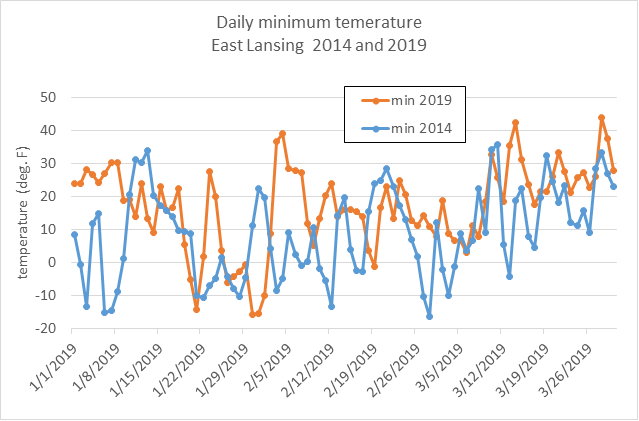Tree, turf and ornamental plant update – May 7, 2019
An update on Lymantria dispar, formerly gypsy moth, white pine bluster rust and winter injury.

Lymantria dispar
Lymantria dispar, formerly gypsy moth, should be hatching soon in many areas of Michigan’s Lower Peninsula. Last year, residents from many areas across the southern half of the Lower Peninsula saw large numbers and reported damage to trees from Lymantria dispar caterpillar feeding. With the ample moisture we have received this spring, it is hopeful the natural pathogen Entomophaga maimaiga will help cause the Lymantria dispar populations to decline.
For more information, see the Michigan State University Extension article, “Lymantria dispar outbreaks may be contained with the help of a little fungus.”
Winter injury
We are seeing winter injury to some shrubs and conifers. Boxwood along with conifers have suffered needle browning while forsythia had poor flowering this spring due to this past winters’ cold temperatures. Boxwoods are subject to damage from winter desiccation as well as cold damage, both of which can lead to extensive browning. Fortunately, winter damage on evergreens often appears worse than it is, and plants frequently recover after some careful pruning to remove affected shoots.
One thing to note is that cold weather in 2014 (and 2015) was much longer lasting than this year. We are seeing some delay in bud break, but believe it is due to the slow accumulation of growing degree-days.
For more information on winter injury, see the MSU Extension article, “Winter damage on conifers beginning to show up.”

White pine blister rust
Orange-yellow blisters caused by white pine blister rust are visible on infected white pine branches. In spring, pale yellow or cream-colored blisters (aecia) rupture through the bark of active cankers on white pine. These blisters will release powdery, orange-yellow spores (aeciospores) that are carried in the wind to the alternate host and cause infection. These spores can only infect Ribes species. On Ribes, the rust fungus will then produce another spore that will infect white pine in mid-summer to early fall.
MSU Diagnostic Services update
Mosquitos
With the abundance of rain and standing water this spring, expect large mosquito numbers. Michigan is blessed with over 60 species of mosquitoes. These can be categorized into two basic groups based on their breeding habits. The first group might be termed spring mosquitoes. Spring mosquitoes produce a single generation of adults each year. Their larvae develop in “spring pools” in low-lying areas that hold water from snowmelt and spring rains. Our wet spring has certainly enhanced the success rate of developing larvae by maintaining adequate water levels in these areas.
Kissing bugs
Several people have called MSU Diagnostic Services worried about kissing bugs. Kissing bugs have not been found in Michigan. Kissing bugs, also known as bloodsucking conenoses (Triatoma spp.), are very large assassin bugs and do not live in Michigan, despite recent media articles claiming they do.



 Print
Print Email
Email